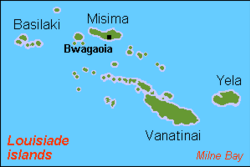Source google.com.pk
The Louisiade Archipelago Rain Forests
The Louisiade Archipelago rain forests contain many endemic species of plants and animals, particularly birds, that help define it as a distinct unit. The main threats to the islands are logging, conversion of habitat into agricultural lands, and gold mining.
Location and General Description
The ecoregion includes a group island chain that lies off the southeastern tip of Papua New Guinea (PNG). The first islands moving eastward in the chain are close to the mainland and include Sideia and Basilaki islands. Further east are the major islands in the archipelago: Misima, Sudest (or Tagula), and Rossel. Sudest Island is the largest (800 square-kilometers (km2)). All of the major islands of the Louisiades are volcanic, although there are numerous smaller islands that are coral formations.
The climate of the Louisiade Archipelago is moist tropical, and the vegetation consists of rain forest, although some of the low-lying smaller islands receive less rainfall. Paijmans categorized most of the ecoregion as small crowned lowland hill forest. This type of forest is shorter (20-30 meters (m) in height) than that found in other areas in New Guinea because of either poor soil conditions or less rainfall. The former is probably the case, as Johns remarked on the very poor soils of Rossel and Misima. Tree genera in pure forest stands include Casuarina, Castanopsis, and Hopea. Paijames listed mixed forest genera for low rainfall areas as Pometia, Canarium, Anisoptera, Cryptocarya, Terminalia, Syzygium, Ficus, and Celtis.







The Louisiade Archipelago Rain Forests
The Louisiade Archipelago rain forests contain many endemic species of plants and animals, particularly birds, that help define it as a distinct unit. The main threats to the islands are logging, conversion of habitat into agricultural lands, and gold mining.
Location and General Description
The ecoregion includes a group island chain that lies off the southeastern tip of Papua New Guinea (PNG). The first islands moving eastward in the chain are close to the mainland and include Sideia and Basilaki islands. Further east are the major islands in the archipelago: Misima, Sudest (or Tagula), and Rossel. Sudest Island is the largest (800 square-kilometers (km2)). All of the major islands of the Louisiades are volcanic, although there are numerous smaller islands that are coral formations.
The climate of the Louisiade Archipelago is moist tropical, and the vegetation consists of rain forest, although some of the low-lying smaller islands receive less rainfall. Paijmans categorized most of the ecoregion as small crowned lowland hill forest. This type of forest is shorter (20-30 meters (m) in height) than that found in other areas in New Guinea because of either poor soil conditions or less rainfall. The former is probably the case, as Johns remarked on the very poor soils of Rossel and Misima. Tree genera in pure forest stands include Casuarina, Castanopsis, and Hopea. Paijames listed mixed forest genera for low rainfall areas as Pometia, Canarium, Anisoptera, Cryptocarya, Terminalia, Syzygium, Ficus, and Celtis.








No comments:
Post a Comment